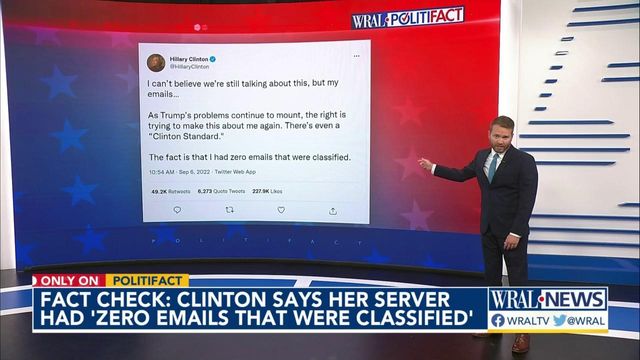Fact check: Clinton says her server 'had zero emails that were classified'
Former Secretary of State Hillary Clinton pushed back against comparisons between her email probe and the search on former President Donald Trump's Florida home, tweeting on Sept. 6 that "I had zero emails that were classified." PolitiFact checks her claim.
Posted — UpdatedFormer Secretary of State Hillary Clinton pushed back against comparisons between her email probe and the search on former President Donald Trump’s Florida home. In a Sept. 6 Twitter thread, Clinton said "the right is trying to make this about me again.
"The fact is that I had zero emails that were classified," Clinton claimed. "I’m more tired of talking about this than anyone, but here we are."
Some of Clinton’s emails contained classified information, but none were found to be marked as such.
What we know about the markings in Clinton’s emails
Clinton’s email troubles started in 2014, when the House Select Committee on Benghazi asked the State Department for all of her emails. The department didn’t have them all because, instead of using only the State Department email system (with an email address ending in @state.gov), Clinton used a personal email address (ending in @clintonemail.com) housed on private servers in her Chappaqua, New York, home.
In 2014, Clinton’s lawyers combed through the private server and turned over about 30,000 work-related emails to the State Department and deleted the rest, which Clinton said involved personal matters, such as her daughter’s wedding plans.
The next day, the State Department explained what the three document markings suggesting classified material were all about. They had to do with what is known as "call sheets," not classified material.
Before a secretary of state calls a foreign leader, staff members prepare a guide known as a call sheet. It gives the context for the call and the key points to hit during the conversation. Early in the process, a call sheet might be marked as sensitive, but by the time it reaches the secretary, it isn’t.
"The process is then to move the call sheet, to change its markings to unclassified and deliver it to the secretary in a form that he or she can use," said then-State Department spokesperson John Kirby July 6, 2016, adding that the confidential markings resulted from human error.
In a July 7, 2016, congressional hearing, Comey said he had not heard what the State Department had said about the call sheets. He explained that classified documents come with headers that give the classification level. Comey acknowledged that the documents in Clinton’s email had no headers. Asked whether the lack of a header would have told Clinton that the material was unclassified, Comey said, "That would be a reasonable inference."
"The emails in question lacked proper classification markings," the report said. "The senders often refrained from using specific classified facts or terms in emails and worded emails carefully in an attempt to ‘talk around’ classified information."
State Department’s own review of Clinton’s email use
The State Department reviewed thousands of documents in Clinton’s emails, and questioned dozens of State Department employees. The investigation took place primarily during Donald Trump’s presidency, running from July 2016 to September 2019.
It focused on the general problem of spillage, the sharing of unmarked but nevertheless classified details. The investigation found 38 people were responsible for 91 violations. It found 497 additional violations in which no one could be held culpable.
The State Department concluded that Clinton’s use of a private email server "carried an increased risk of compromise or inadvertent disclosure." (The 2018 Justice Department review found no evidence that the server was hacked.)
On the other hand, State Department investigators concluded that although staff members sometimes shared information that they shouldn’t have, by and large, they "were aware of security policies and did their best to implement them in their operations."
They noted that "none of the emails at issue in this review were marked as classified." They also said there was "no persuasive evidence of systemic, deliberate mishandling of classified information."
Clinton’s longtime attorney, David Kendall, highlighted the State Department’s findings as evidence for Clinton’s claim.
Ambiguities in the classification system
There is debate over the classification of material in the emails.
Blanton said that in Clinton’s case, he saw signs of a rift between the State Department and intelligence agencies. The State Department reviewers, he said, initially found no classified material, while the intelligence agencies said there were potentially hundreds of instances.
PolitiFact ruling
Clinton claimed she had "zero emails that were classified."
At the conclusion of all investigations, no documents included in her emails were found to be marked as classified.
However, hundreds of bits of information that State Department officials considered classified did end up in emails on Clinton’s private server.
Clinton is technically correct, but she sidesteps the references to classified information that staffers introduced into the email chains.
We rate this claim Half True.
Related Topics
Copyright 2024 Politifact. All rights reserved.





